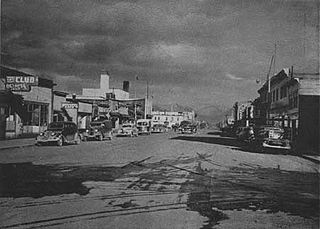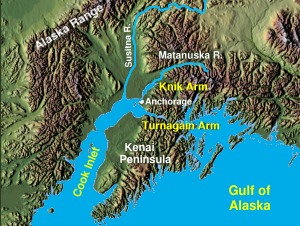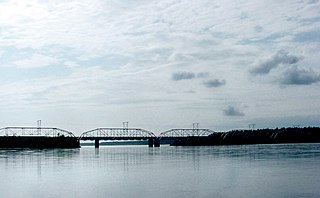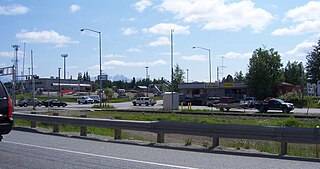
Matanuska-Susitna Borough is a borough located in the U.S. state of Alaska. Its borough seat is Palmer, and the largest community is the census-designated place of Knik-Fairview. As of the 2020 census, the borough's population was 107,801.

Knik River is a census-designated place (CDP) in Matanuska-Susitna Borough in the U.S. state of Alaska. Located 15 miles southeast from Palmer along the Knik River, it is part of the Anchorage, Alaska Metropolitan Statistical Area. The population was 792 at the 2020 census, up from 744 in 2010.

Lazy Mountain is a census-designated place (CDP) in Matanuska-Susitna Borough, Alaska, United States. Located east of Palmer along the Matanuska River. At the 2020 census the population was 1,506, up from 1,479 in 2010.

Palmer is a city in and the borough seat of the Matanuska-Susitna Borough, Alaska, United States, located 42 miles (68 km) northeast of Anchorage on the Glenn Highway in the Matanuska Valley. It is the ninth-largest city in Alaska, and forms part of the Anchorage Metropolitan Statistical Area. As of the 2020 census, the population of the city is 5,888, down from 5,937 in 2010.

The Susitna River is a 313-mile (504 km) long river in the Southcentral Alaska. It is the 15th largest river in the United States, ranked by average discharge volume at its mouth. The river stretches from the Susitna Glacier to Cook Inlet's Knik Arm.

Knik Arm is a waterway into the northwestern part of the Gulf of Alaska. It is one of two narrow branches of Cook Inlet, the other being Turnagain Arm. Knik Glacier empties into the Knik Arm. The Port of Anchorage is located on the arm.
Susitna may refer to any of:
James L. Sykes is a producer and elected official in the state of Alaska, who helped found the Green Party of Alaska.
Matanuska–Susitna College in Palmer, Alaska, north of Anchorage, is part of the University of Alaska Anchorage system. The college began in 1958 as Palmer Community College, changing its name in 1963 to correspond to the Matanuska-Susitna Borough where it is located. It is commonly called Mat-Su College. Total enrollment is about 1,100 students per semester. Dr. Marie Gardner will start as the college director in October of 2023. The college is located at 8295 E College Dr. Palmer Alaska.

After congress approved the completion of the Alaska Railroad from Seward to Fairbanks in 1914, it was decided that a new town should be built as a port and rail hub along the route. The decision was made to develop a site near Ship Creek on Cook Inlet. Survey parties visited the area in 1914 and researched possible routes for the rails and options for siting the new town. Anchorage was originally settled as a tent city near the mouth of Ship Creek in 1915, and a planned townsite was platted alongside the bluff to the south. Anchorage was mostly a company town for the Alaska Railroad for its first several decades of existence.

The Knik Arm Bridge is a dormant proposal for a 1.74-mile (2.80 km) bridge across Cook Inlet's Knik Arm to link the two fastest growing parts of Alaska – Anchorage and the Matanuska-Susitna Borough.

The Knik River is a 25-mile-long (40 km) river in the U.S. state of Alaska. Its source is at Knik Glacier, from which it flows northwest and west and empties into the head of Cook Inlet's Knik Arm, near the mouth of the Matanuska River. It is bridged twice where the Old Glenn Highway crosses it near the Butte, and also bridged on the Hayflats.

As of 2020, Alaska has a population of 733,391.

Wasilla High School (WHS) is a public secondary school in Wasilla, Alaska, United States, serving students in grades 9–12. The school is part of the Matanuska-Susitna Borough School District, with admission based primarily on the locations of students' homes.
Matanuska-Susitna Borough School District (MSBSD) is a school district based in the city of Palmer, Alaska. It serves 40 schools across Mat-Su Borough, which each enroll from 15 to 1300 students. The estimated sum of the total number of students attending schools in this district is 15,969. MSBSD is the second-largest school district in Alaska, with the largest district being Anchorage School District.

The City of Wasilla (Dena'ina: Benteh) is a city in Matanuska-Susitna Borough, United States and the fourth-largest city in Alaska. It is located on the northern point of Cook Inlet in the Matanuska-Susitna Valley of the southcentral part of the state. The city's population was 9,054 at the 2020 census, up from 7,831 in 2010. Wasilla is the largest city in the borough and a part of the Anchorage metropolitan area, which had an estimated population of 398,328 in 2020.
Linda K. Menard is a former Republican member of the Alaska Senate. She represented the G District from 2009 through 2012. She had previously served for over a decade on the Matanuska-Susitna Borough school board, including as president.

Matanuska-Susitna Valley is an area in Southcentral Alaska south of the Alaska Range about 35 miles (56 km) north of Anchorage, Alaska. It is known for the world record sized cabbages and other vegetables displayed annually in Palmer at the Alaska State Fair. It includes the valleys of the Matanuska, Knik, and Susitna Rivers. 11,000 of Mat-Su Valley residents commute to Anchorage for work . It is the fastest growing region in Alaska and includes the towns of Palmer, Wasilla, Big Lake, Houston, Willow, Sutton, and Talkeetna. The Matanuska-Susitna Valley is primarily the land of the Dena'ina and Ahtna Athabaskan people.

The Knik Site, also known as the Old Knik Townsite, is the location in Matanuska-Susitna Borough, Alaska that was once home to the largest settlement on Cook Inlet. The only surviving remnants of the community are a former log roadhouse, now a museum operated by the Wasilla-Knik Historical Society, and a log cabin. The Knik area had long been a meeting point of Native Alaskans, and in 1898 it became the principal community on Cook Inlet from which goods were shipped into the interior. In 1916 the Alaska Railroad reached the site of present-day Anchorage, bypassing Knik and leading to Anchorage's growth. When the railroad reached Wasilla, Knik lost all importance as a transshipment point, and its buildings were either abandoned or moved to one of the other communities. Knik is located about 13 miles (21 km) southwest of Wasilla.
Dorothy Swanda Jones was an Alaskan politician in the Matanuska-Susitna Borough. After her death, the Mat-Su Borough Administrative Headquarters building, located in Palmer, Alaska, was renamed in her honor as the Dorothy Swanda Jones Building in 1994.














